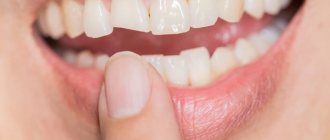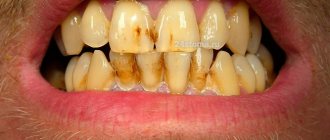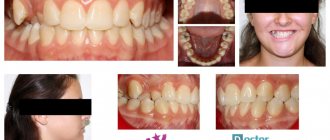Common reasons
Darkening of teeth can look different:
- If the discoloration is caused by plaque that is not properly removed, the color of the dentition appears uneven, darker at the base and lighter towards the edges; Possible causes are abuse of coffee and tea (strongly brewed drinks have a powerful coloring effect) and smoking. It is very difficult for tea, coffee and nicotine lovers to maintain a snow-white smile; they practically have to choose between beautiful teeth and established habits.
- If one or more teeth have a pronounced color difference, we have to talk about poor-quality canal treatment or the development of secondary caries (after removal of the nerve, the darkening of the tooth is explained by the lack of nutrition and is natural; a dark rim around the filling is a signal for its immediate replacement due to a violation of the tightness ). A tooth can also be darkened by trauma that causes nerve death or internal bleeding; whiteness can only be restored through careful treatment of the canals, sometimes with intracanal bleaching.
Black plaque is not only a death sentence for a smile, but also a possible cause of caries. Only regular visits to the dentist will help you avoid troubles and keep your teeth healthy and white.
Why do children's teeth turn black?
While many explanations can be found for the darkening of tooth enamel in adults, black teeth in a child cause bewilderment and confusion among parents. In fact, a child’s teeth can darken even with careful hygiene and in the absence of chronic diseases.
There are several reasons for the problem, the main one is improper nutrition with the amount of sweets in the diet: microbes, like people, love sweets, the effect of sweet food on tooth enamel is negative, associated with the appearance of a dense microbial biofilm. Other common reasons:
- genetic predisposition
- calcium deficiency
- dysbacteriosis
- early caries
If you notice dark gingival stripes on your child’s teeth, do not ignore them: the appearance of the so-called Priestley’s plaque is one of the consequences of the development of the digestive system, which resolves itself with age, but it is better to clarify the diagnosis with a dentist. Dark spots and dots on the baby’s teeth should also cause concern: contrary to the popular belief that baby teeth should not be treated, in the absence of adequate treatment, permanent ones that grow to replace them are often damaged.
Black teeth in a child are an alarming signal that requires an immediate preventive examination by a dentist, since all pathologies develop rapidly in childhood.
Black teeth: treatment methods
What can you do at home?
It is well known that you can make your teeth lighter by quitting smoking and limiting your consumption of coloring drinks such as strong coffee and tea.
Another obvious requirement is regular brushing of teeth with the addition of additional dental hygiene products (dental floss, rinses, etc.)
On the Internet you can find many recommendations for changing the shade of tooth enamel using folk remedies, but you should not rely on such solutions, since only professional hygiene and whitening give real results. Don't self-medicate!
If you decide to see a dentist
At the first appointment, provide the specialist with as much information as possible about your health, lifestyle and bad habits - this will help the dentist quickly and accurately stop the cause of the pathology.
If the darkening is due to tooth decay, recent nerve removal, or other dental problems, treatment will be required. Today, dentistry fights for every tooth, offering solutions even in situations that seem hopeless, including restoring teeth with crowns or veneers.
The method of treatment is selected individually based on the general condition of the oral cavity.
The tooth under the crown is rotting: what to do?
A dental crown is a dental element that helps restore the integrity of a tooth and its function. Over time, due to a combination of certain factors, decay processes may begin, which are accompanied by bad breath, pain and swelling of adjacent tissues, as well as darkening of the tooth. In such cases, you should immediately seek help from a doctor.
Why does a tooth deteriorate under a denture?
The main reason that causes tooth decay under the crown is its loose fit to the gum, when a cavity forms between the implanted element and the gum. Food particles get there, which is accompanied by rotting processes. This occurs when the crown is installed incorrectly or the materials are depressurized.
The photo shows tooth decay under the crown.
When the implant is not properly cared for, inflammation can develop. This condition is fraught with the occurrence of secondary caries, which subsequently destroys the supporting tooth.
Attention: before implantation, it is necessary to undergo preliminary treatment, that is, implants are installed only on healthy teeth!
Another reason for rotting can be the use of poor quality materials. Problems often arise during the manufacture of the prosthesis, or the dentist performs poor-quality pulp removal.
In patients with chronic pathologies of the digestive tract and gallbladder, rotting is observed due to changes in the acidity of saliva. With pathology of bone tissue, namely a violation of the absorption and assimilation of calcium ions, tooth decay also begins.
Problems with the dental crown can be caused by bad habits, especially smoking, and poor diet.
Clinical symptoms
An unpleasant odor appears first. It cannot be eliminated either by thorough cleaning or enhanced oral hygiene using antibacterial rinses.
As mentioned above, food debris gets clogged into the cavity between the crown and the tooth. This promotes the proliferation of bacterial flora, and subsequently leads to the appearance of an unpleasant odor.
Patients also often complain of a strange taste in the mouth, pus discharge, and pain. Visually, the tooth near the gum will turn black, and the implanted element itself will become mobile, which indicates a violation of fixation. Also, during the examination, redness and swelling of the gums near the damaged tooth will be noticeable, and if the situation is serious, then signs of swelling to the affected person.
What to do if a tooth rots
If you detect at least one of the above signs, you should immediately contact your dentist, because if you do not receive qualified help in a timely manner, serious consequences may develop, such as:
- Damage to other teeth.
- Inflammation of the oral mucosa.
- Sepsis (when pathogenic microorganisms enter the systemic bloodstream).
- Infectious damage to organs (bacteria spread throughout the body through the bloodstream, settle in various tissues and organs, causing their damage).
Attention: under no circumstances should you self-medicate, as this will only worsen the condition of the tooth.
For treatment, it is necessary to determine the causes of the inflammatory process, how far and deep it has spread, and most importantly, what condition the root canals are in. Only a dentist can fully accomplish this. He will conduct a diagnosis and offer treatment options.
What if food gets under the crown?
It is rare to encounter a situation where, after installing a dental crown, the patient is not bothered by anything. Over time, pain and discomfort go away. However, if they persist, and in addition there is an unpleasant odor or pain when chewing, this is a good reason to consult a doctor. If food gets stuck between the implant and adjacent teeth, the crown will need to be replaced because it was not installed correctly.
Crown loss
The implantation element may fall out if it is installed incorrectly. The problem lies in the fact that the prosthesis is fixed to unhardened cement.
The photo shows a crown falling out
There is a risk of accidental swallowing of the crown, so you should immediately consult a doctor. The dentist will recommend re-fixation on a stronger base.
Taste of blood in the mouth
The taste of blood in the mouth may indicate poor oral hygiene. In the place where the gum meets the enamel there is a circular ligament of the tooth. Food debris often gets clogged there, which can lead to bleeding. If this happens, you should improve your oral hygiene and be sure to use a irrigator for cleaning.
Putrid smell
While eating, pieces of food get caught under the crown. There, a favorable environment is formed for the growth of bacteria, which causes the process of rotting food and bad breath. Suppuration is accompanied by pain and, in some cases, discharge.
Many patients try to cope with the problem on their own, using various mouth rinses or even traditional medicine. However, the effect is very short-lived. In addition, the processes of inflammation and rotting under the crown are only getting worse.
In order to avoid the appearance of bad breath, it is necessary to properly care for the oral cavity and the installed implant.
Discharge
Discharge from under the crown may appear when pressing on the structure. This happens when gum inflammation develops there. Pus may be released when you press or open the pus sac, which will temporarily relieve the soreness. However, the problem will not be solved. If purulent discharge appears, you should urgently consult a doctor, as this process can lead to an abscess - acute inflammation in the root area with copious discharge of pus.
Tooth color changes
The reasons for the color change may be different:
- medications (tetracycline);
- injury;
- pulpitis;
- fluorosis (increased fluoride intake from water and food).
Changes in the color of teeth and gums directly depend on the materials from which the crown is made. If metal ceramics were used, then in the area near the gums it is possible to see the edge of white ceramics covering the metal frame. Sometimes it is a little translucent, and it seems that the tooth has turned blue. To achieve a more aesthetic effect, it is recommended to use a non-metal crown, for example, based on zirconium dioxide. The base of such crowns is white itself, so it will not stand out from the others.
Darkening may occur after root canal treatment - this is absolutely normal and will go away with time.
The color of the tooth may change if the expiration date of the dental element has passed.
Important: crowns should be replaced every 5-7 years, even if their shelf life is 10 years. Because there is a gradual change in gum tissue. They atrophy, tooth tissue is exposed, and it becomes more susceptible to external factors of aggression.
Has your tooth turned black?
Blackening of the tooth is dangerous. This indicates tissue destruction and requires immediate treatment. In such cases, the crown is removed, the dentist assesses the condition of the tooth, and then prescribes appropriate treatment.
Treatment of a tooth under a crown
The dentist will select the correct treatment after visiting the clinic. It depends on how badly the tooth is damaged. Based on this, they distinguish:
- Replacement of the prosthesis - if the stump was not affected. It will be enough to clean out any remaining food from under the crown and replace it. This is possible if you seek help in a timely manner.
- Additional installation of a core inlay is a system with so-called “legs” that fix the inlay on the tooth canals.
The photo shows stump inlays
Next, a crown is attached to it. This method of treatment is recommended if the roots of the tooth are preserved.
— Removal and implantation. If the entire tooth rots, the dentist removes it, performs hygienic cleaning of the oral cavity, and prescribes treatment for periodontitis. Only after this will the patient be referred for re-implantation.
Attention: when installing a dental crown for the first time, you should pay attention to what guarantees the dental clinic provides and what assistance it can provide in case of problems with the installed implant.
Correct care of a dental crown
Careful care is important and necessary for any type of implant, however, each of them has its own characteristics.
| Implantable element | Features of care | Additional funds |
| Metal-ceramic crowns | It is carried out in the same way as caring for regular teeth. You can use any brush. The movement should go in the direction from the gums to the edge of the crown. | To remove plaque between teeth, it is recommended to use special brushes and dental floss. |
| Bridges | Particular attention is paid to the flushing channels between the gums and crowns. | Also used are brushes, thread and an irrigator, which allows you to quickly and efficiently clean the cavities from food debris. |
Bridges Particular attention is paid to the flushing channels between the gums and crowns. Also used are brushes, thread and an irrigator, which allows you to quickly and efficiently clean the cavities from food debris. Table 1. – Correct care of implanted elements.
There are some dietary recommendations when installing a dental implant:
- Reduce the consumption of drinks high in caffeine and coloring pigments (tea, coffee, wine, beets and others).
- Do not eat very hot or very cold food as this may cause the materials to crack or become unfastened.
- You should not clean seeds or nuts with teeth that have a crown installed.
- Solid food must first be cut into smaller pieces (this reduces the load on teeth with a crown).
- You should not overuse chewing gum, toffees and other viscous foods, because they can stick to the implant and contribute to its loss.
It is also recommended to undergo special professional ultrasonic cleaning at the dentist several times a year.
Attention: the patient must notify the doctor about the installed implants.
Oral hygiene
In order to avoid problems after implant installation, it is necessary to carry out thorough daily oral care.
Firstly, you need to brush your teeth 2 times a day using special brushes. Secondly, after each meal it is necessary to rinse your mouth with special means and then with running water. Thirdly, special additional products have been developed that are recommended for oral care:
- Interproximal brush for cleaning hard-to-reach areas and spaces between the crown and teeth.
- Bundle brush for cleaning the space between the crown and the tooth.
- Dental floss for cleaning spaces between teeth.
- Irrigator (a device that operates under pressure: water pressure removes food debris from the most inaccessible areas).
When to see a doctor
If you experience any discomfort, you should make an appointment with your dentist. Even if there are no inflammatory processes or disorders, consulting a professional is still better than self-medication. The doctor will clearly explain the cause and reassure the patient, and if a pathology is detected, he will immediately prescribe treatment.
Attention: you should not hesitate to go to the doctor, the pain, unpleasant odor and discharge from under the crown will not go away on their own. These conditions require quality treatment!
Methods for treating black teeth
- If black streaks or stains appear on the teeth due to improper care, professional hygiene is prescribed. In our clinic you can sign up for a “denticure”, your teeth will be free of plaque, and your smile will be attractive again
- If your teeth are blackened due to food dyes, then professional or home whitening, using special toothpastes and eliminating coloring foods from your daily menu will help.
- If your teeth have turned black due to caries, then sanitation with further restoration of the tooth and preventive procedures to strengthen your teeth are necessary. No dentist will remove black teeth without understanding the cause.
Provide thorough and competent oral care - and you will never know what black plaque is. See a dental hygienist to learn how to properly brush your teeth and choose a toothbrush and toothpaste.
Causes of darkening of enamel
Discoloration of enamel and dentin can be caused by:
- carious lesion,
- pulp necrosis,
- long-term use of tetracycline antibiotics in high dosages,
- violation of the acid-base balance in the oral cavity,
- overdose of fluoride or zinc,
- smoking,
- some diseases of the gastrointestinal tract,
- improper filling,
- excessive consumption of coloring foods and drinks - black coffee, strong tea, pomegranate and grape juice, soy sauce, blueberries and blackberries.
To return the enamel to its natural color, you need to make an appointment with a dentist. The doctor will determine why the crown of the tooth has darkened and will suggest the optimal restoration method, taking into account the age and health characteristics of the patient.











